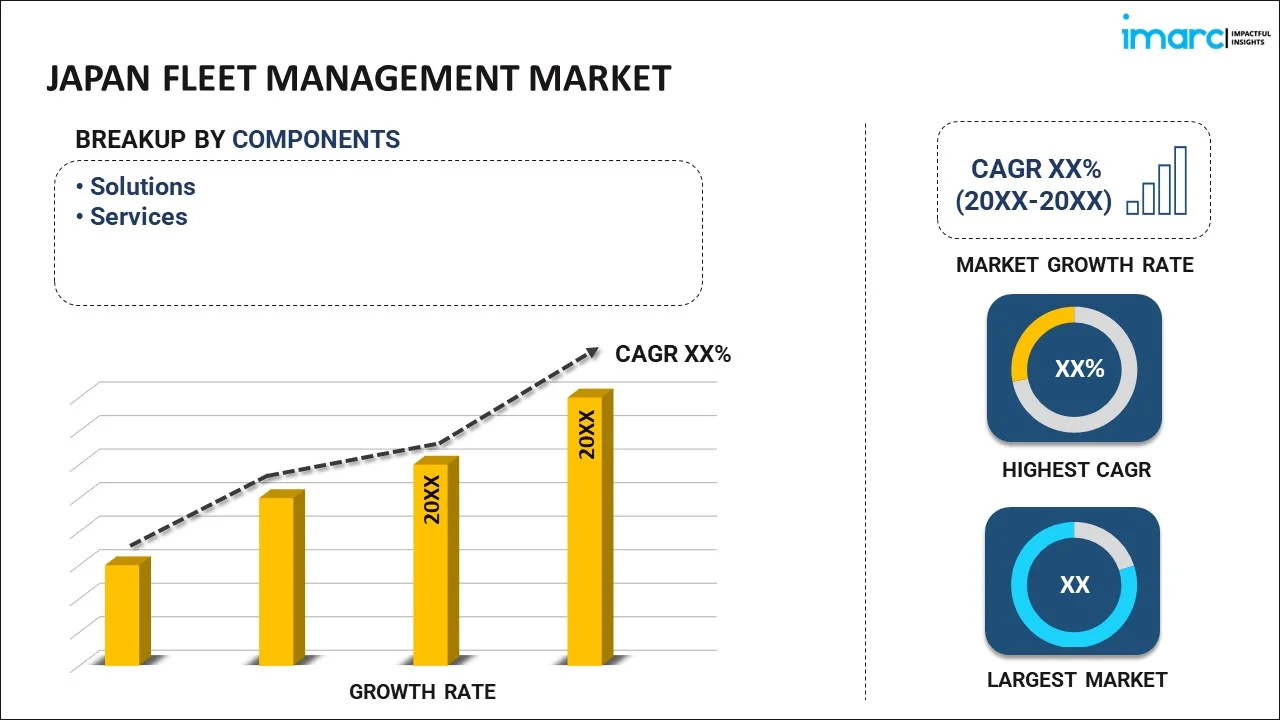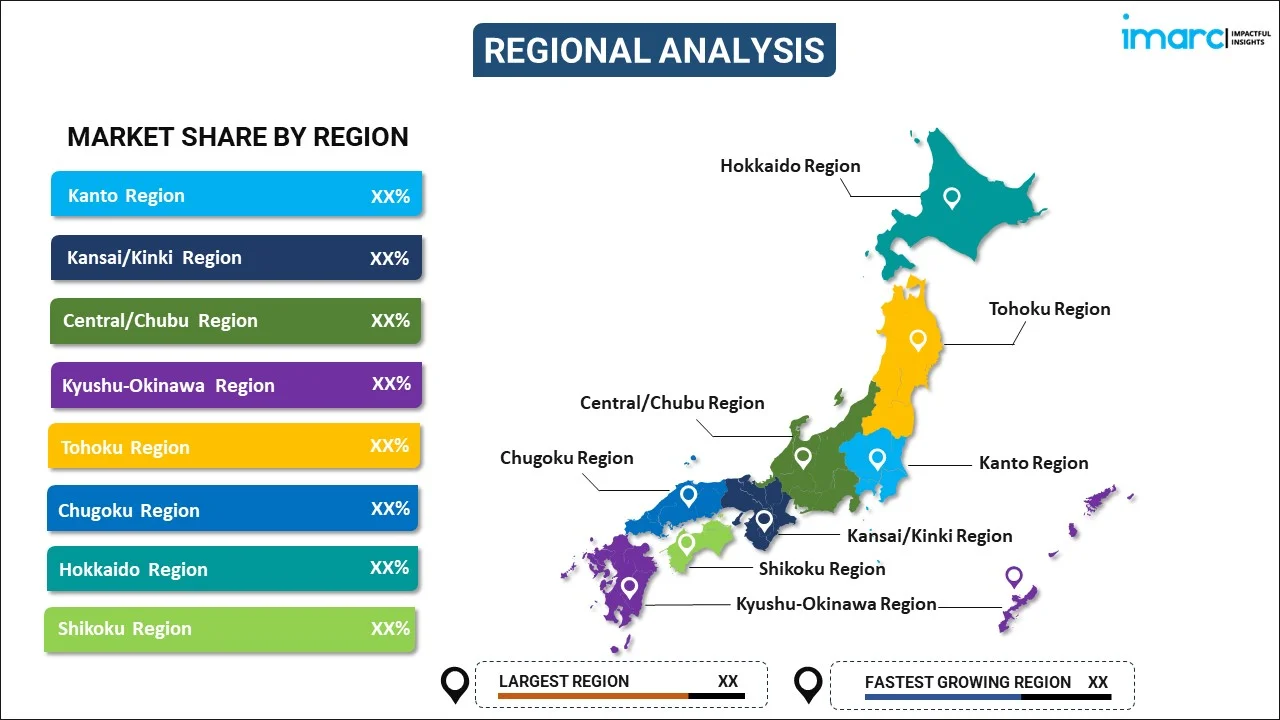
Japan Fleet Management Market Report by Component (Solutions, Services), Vehicle Type (Commercial Vehicles, Passenger Cars, Aircrafts, Watercrafts), End Use Sector (Automotive, Energy and Utilities, Manufacturing, Retail, Transportation and Logistics, Construction, and Others), Technology (GNSS, Cellular Systems), Deployment Type (Cloud-based, On-premises, Hybrid), and Region 2025-2033
Market Overview:
Japan fleet management market size reached USD 1,703.3 Million in 2024. Looking forward, IMARC Group expects the market to reach USD 3,917.4 Million by 2033, exhibiting a growth rate (CAGR) of 9.7% during 2025-2033. The market is being driven by several key factors, including the growing need for live vehicle monitoring and enhancement, the continual escalation of regulatory adherence and safety standards, and an intensified emphasis on minimizing operational costs.
|
Report Attribute
|
Key Statistics
|
|---|---|
|
Base Year
|
2024 |
|
Forecast Years
|
2025-2033
|
|
Historical Years
|
2019-2024
|
| Market Size in 2024 | USD 1,703.3 Million |
| Market Forecast in 2033 | USD 3,917.4 Million |
| Market Growth Rate (2025-2033) | 9.7% |
A fleet management system is a comprehensive and technology-oriented solution devised to efficiently oversee and streamline the operations of a group of vehicles or assets. It grants businesses and organizations the capacity to oversee, trace, and administer their vehicles in real-time. Key functionalities typically include GPS-based vehicle tracking, remote diagnostics, monitoring driver behavior, optimizing routes, and scheduling maintenance. Collectively, these features enable businesses to improve operational efficiency, curtail expenses, and elevate overall productivity. Fleet management systems offer valuable insights into vehicle performance, driver conduct, and fuel usage. Consequently, these systems find broad utility across various sectors as they aid in ensuring adherence to regulations and safety protocols, particularly crucial in industries such as logistics, transportation, and delivery services.
Japan Fleet Management Market Trends:
The Japan fleet management market is set to experience substantial growth driven by the mounting requirement for augmented operational efficiency and cost management across key sectors including logistics, transportation, and delivery services. Additionally, the imposition of stringent governmental regulations and a heightened emphasis on safety and environmental considerations are compelling enterprises to invest in fleet management systems, ensuring regulatory adherence and reducing their ecological footprint, thereby fostering positive market growth. The increasing necessity for real-time monitoring and data-informed decision-making, facilitated by GPS-based tracking and advanced analytics integrated within fleet management systems, represents another significant factor contributing to market expansion. Moreover, the rapid proliferation of connected vehicles and the deployment of Internet of Things (IoT) technology are fueling market growth, enabling seamless communication between vehicles and centralized management platforms. Furthermore, the ever-expanding e-commerce sector and the surge in last-mile delivery services have spurred the demand for efficient fleet management, thereby contributing to the market's growth trajectory. Apart from this, the fleet management system market is significantly influenced by ongoing technological progress. Developments in GPS tracking, IoT connectivity, and data analytics empower businesses by providing them with immediate insights into their fleet operations, which is anticipated to fuel the market growth over the forecasted period.
Japan Fleet Management Market Segmentation:
IMARC Group provides an analysis of the key trends in each segment of the market, along with forecasts at the country level for 2025-2033. Our report has categorized the market based on component, vehicle type, end use sector, technology, and deployment type.
Component Insights:

- Solutions
- Fleet Telematics
- Driver Information Management
- Vehicle Maintenance
- Safety and Compliance Management
- Others
- Services
- Installation and Integration Services
- After-Sales Support Services
- Consulting Services
The report has provided a detailed breakup and analysis of the market based on the component. This includes solutions (fleet telematics, driver information management, vehicle maintenance, safety and compliance management, and others) and services (installation and integration services, after-sales support services, and consulting services).
Vehicle Type Insights:
- Commercial Vehicles
- Passenger Cars
- Aircrafts
- Watercrafts
A detailed breakup and analysis of the market based on vehicle type have also been provided in the report. This includes commercial vehicles, passenger cars, aircrafts, and watercrafts.
End Use Sector Insights:
- Automotive
- Energy and Utilities
- Manufacturing
- Retail
- Transportation and Logistics
- Construction
- Others
The report has provided a detailed breakup and analysis of the market based on the end use sector. This includes automotive, energy and utilities, manufacturing, retail, transportation and logistics, construction, and others.
Technology Insights:
- GNSS
- Cellular Systems
A detailed breakup and analysis of the market based on technology have also been provided in the report. This includes GNSS and cellular systems.
Deployment Type Insights:
- Cloud-based
- On-premises
- Hybrid
The report has provided a detailed breakup and analysis of the market based on the deployment type. This includes cloud-based, on-premises, and hybrid.
Regional Insights:
 `
`
- Kanto Region
- Kansai/Kinki Region
- Central/ Chubu Region
- Kyushu-Okinawa Region
- Tohoku Region
- Chugoku Region
- Hokkaido Region
- Shikoku Region
The report has also provided a comprehensive analysis of all the major regional markets, which include Kanto Region, Kansai/Kinki Region, Central/ Chubu Region, Kyushu-Okinawa Region, Tohoku Region, Chugoku Region, Hokkaido Region, and Shikoku Region.
Competitive Landscape:
The market research report has also provided a comprehensive analysis of the competitive landscape in the market. Competitive analysis such as market structure, key player positioning, top winning strategies, competitive dashboard, and company evaluation quadrant has been covered in the report. Also, detailed profiles of all major companies have been provided.
Japan Fleet Management Market Report Coverage:
| Report Features | Details |
|---|---|
| Base Year of the Analysis | 2024 |
| Historical Period | 2019-2024 |
| Forecast Period | 2025-2033 |
| Units | Million USD |
| Scope of the Report | Exploration of Historical Trends and Market Outlook, Industry Catalysts and Challenges, Segment-Wise Historical and Future Market Assessment:
|
| Components Covered |
|
| Vehicle Types Covered | Commercial Vehicles, Passenger Cars, Aircrafts, Watercrafts |
| End Use Sectors Covered | Automotive, Energy and Utilities, Manufacturing, Retail, Transportation and Logistics, Construction, Others |
| Technologies Covered | GNSS, Cellular Systems |
| Deployment Types Covered | Cloud-based, On-premises, Hybrid |
| Regions Covered | Kanto Region, Kansai/Kinki Region, Central/ Chubu Region, Kyushu-Okinawa Region, Tohoku Region, Chugoku Region, Hokkaido Region, Shikoku Region |
| Customization Scope | 10% Free Customization |
| Post-Sale Analyst Support | 10-12 Weeks |
| Delivery Format | PDF and Excel through Email (We can also provide the editable version of the report in PPT/Word format on special request) |
Key Questions Answered in This Report:
- How has the Japan fleet management market performed so far and how will it perform in the coming years?
- What has been the impact of COVID-19 on the Japan fleet management market?
- What is the breakup of the Japan fleet management market on the basis of component?
- What is the breakup of the Japan fleet management market on the basis of vehicle type?
- What is the breakup of the Japan fleet management market on the basis of end use sector?
- What is the breakup of the Japan fleet management market on the basis of technology?
- What is the breakup of the Japan fleet management market on the basis of deployment type?
- What are the various stages in the value chain of the Japan fleet management market?
- What are the key driving factors and challenges in the Japan fleet management?
- What is the structure of the Japan fleet management market and who are the key players?
- What is the degree of competition in the Japan fleet management market?
Key Benefits for Stakeholders:
- IMARC’s industry report offers a comprehensive quantitative analysis of various market segments, historical and current market trends, market forecasts, and dynamics of the Japan fleet management market from 2019-2033.
- The research report provides the latest information on the market drivers, challenges, and opportunities in the Japan fleet management market.
- Porter's five forces analysis assist stakeholders in assessing the impact of new entrants, competitive rivalry, supplier power, buyer power, and the threat of substitution. It helps stakeholders to analyze the level of competition within the Japan fleet management industry and its attractiveness.
- Competitive landscape allows stakeholders to understand their competitive environment and provides an insight into the current positions of key players in the market.
Need more help?
- Speak to our experienced analysts for insights on the current market scenarios.
- Include additional segments and countries to customize the report as per your requirement.
- Gain an unparalleled competitive advantage in your domain by understanding how to utilize the report and positively impacting your operations and revenue.
- For further assistance, please connect with our analysts.

 Inquire Before Buying
Inquire Before Buying
 Speak to an Analyst
Speak to an Analyst
 Request Brochure
Request Brochure
 Request Customization
Request Customization



.webp)




.webp)












